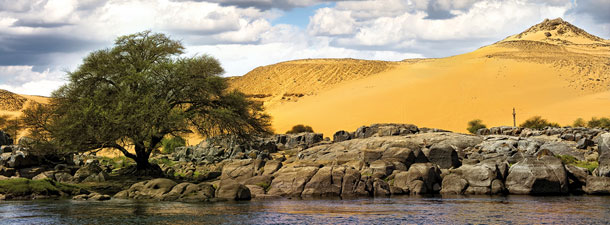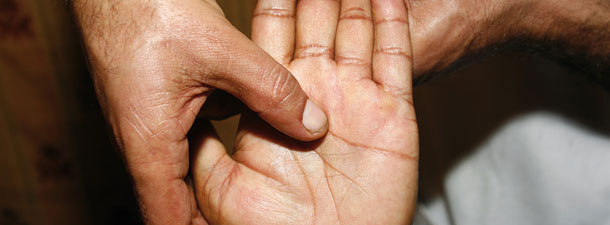
Water For All: The Nile Basin Conundrum
December 8, 2012
Nonno Panda and the Beautiful Little Girl
December 8, 2012Known today as an “alternative” system of medicine, Ayurveda actually predates modern allopathic medicine by millennia. But it is far from primitive or superstitious. Given the limitations of their time, the Ayurvedic physicians were sharp observers and rigorous scientists. Their wisdom, while expressed in somewhat arcane terms compared to the more technical medical language of today, has stood the test of time in many ways. Ayurveda (and other traditional medical systems) is used in some form by around 80% of the people in India, where it originated and where it is regulated and supported by the government in many ways.
A
Ayurveda is an Indian system of traditional medicine that has been in existence for over five thousand years. The term comes from the Sanskrit words ayuh, meaning “life or vital power” and veda meaning “knowledge” – the knowledge of long life. The ancient Ayurvedic physicians were true scientists for their time, making and fine-tuning observations over generations about the relationship between living humans and their environments. For centuries, Ayurveda was passed down as an oral tradition. Eventually, though, written texts on the principles were compiled, the oldest being the Atreya Samhita (1500 BC), which is considered to be the oldest medical text in the world. The Charaka Samhita, compiled by Charaka, a travelling Indian healer and physician, is considered the most important work on the ancient practice of Ayurveda and is central to modern-day Ayurvedic practice as well. Charaka Samhita divides the discipline into eight specific branches – internal medicine, ophthalmology, otolaryngology, toxicology, psychiatry, pediatrics, the science of rejuvenation, and the science of fertility. It seems the ancient Indian people and their physicians had concerns similar to our own today.

Ayurveda utilises various modalities for healing based on the five senses: taste, touch, sound, sight, and smell. In this system the key to health and healing is knowledge of the individual’s own unique body system and life force, not just the symptoms of illness. Health in Ayurveda means the body is free of toxins; the mind is at peace; the emotions are calm and happy; wastes are efficiently eliminated; the organs function normally; and the immune system is strong and indeed this definition of health certainly holds true today. In our natural state we are healthy, happy, and at peace. Disease is the imbalance or disruption of our natural state. In this tradition, disease is more that just a physical state. It has a spiritual, mental and emotional component – something we are starting to pay more attention to in the West. Health requires you to make wise and knowledgeable choices, not only for the body, but for the spirit, soul, and mind as well.

The causes of disease in Ayurveda are:
1- The Senses – continuous pursuit of pleasurable things to the point of disharmony.
2- The Intellect- we know what we should do but make consistently poor choices anyway – not enough sleep, low-nutrition foods, upsetting situations.
3- Time – we have no control over linear time, but the pace at which our mind works can contribute to increased stress. Stress contributes to changes in the body’s physiology. This in turn increases cellular metabolism and can expedite the wearing out of cells, disease and ageing.
The way back to good health is through stillness, yoga, meditation, maintaining a connection to nature, staying present in the moment, and honouring our essential selves.

Everything in Ayurveda has an essential nature based on five elements – Ether (celestial gases which carry the vibration of sound), Air, Fire, Water, and Earth. From these elements, the three Doshas – Vata (wind), Pitta (bile), and Kapha (phlegm) – are derived. The Doshas might be best described as humours, or elemental energies. In a healthy state, these energies are balanced in the body and systems of an individual. We only notice the effects of the Doshas when they are out of balance, thus causing disease of the physical, mental or emotional body. The three Doshas combine in different proportions to make up a person’s individual personality, mind and physical attributes.

One Dosha can dominate in an individual or a person might be bi-doshic or tri-doshic. The choices you make in life should be geared to maintain the balance of your Doshas. For example a Vata (wind or air) person, who can be quick, ungrounded and cold, would want to incorporate warm foods that are salty or sweet, a small amount of animal protein, routine and slow, relaxing exercise, avoiding a raw diet and extreme aerobic workouts. A Pitta personality (fire or bile) might not want to eat hot and spicy foods in the summer nor do Bikram yoga. A Kapha (Earth) person might want to do an aerobic activity every day, restrict wheat and dairy, and eat spicy foods when they are imbalanced.

Hey there! WHAT’S YOUR DOSHA?
Which list sounds like you?
If you have too much Vata you:
- get as much stimulation as possible.
- have a crowded social calendar.
- never miss an event.
- eat quickly and don’t chew your food.
- don’t have an established routine.
- exercise a lot, then a little, then not at all, then a lot.
- love fast, cold, or frozen foods.
- choose iced coffee as your favourite drink.
- travel a lot, and when you’re there you run, jump, dance and skip.
- think if a little is good,more, more, more is better.
- surf the internet for sales, then go shopping, then surf and shop at the same time
- like rooms cold, arctic cold.
- shop some more.
- make a lot of noise, like a lot of noise.
- make a lot of noise running and jumping in the afternoon.
If you have too much Pitta you:
- are as intense as possible: go for it! Get it done!
- turn up the heat.
- are extremely competitive – play to win.
- take a lot of risks.
- exercise at noon in a hot Bikram or Vinyasa flow room.
- work overtime every night, don’t get paid, do it for free, then get angry.
- eat hot chili peppers on everything.
- argue as much as possible.
- fill up on red meat.
- have your fourteenth cup of coffee today – no problem!
- spend a lot of time in the sun
- are impatient, impatient, impatient!
If you have too much Kapha you:
- want to slow down – why is everyone moving so fast?
- lets things pile up and get cluttered.
- sit on the couch, watch TV, and eat lots of sweets – both before and after your pasta.
- eat ice cream right before bed? Sure! Two bowls!
- tend to procrastinate. Why do today what you could do next year?
- sleep eight hours, find it’s not enough; then ten’s not enough, get up at noon.
- live in a basement – preferably mouldy.
- ignore complaints.
If you recognise yourself clearly on one of these lists, then your Dosha is unbalanced and there is too much expression of that particular Dosha. If you relate strongly to two lists, your imbalance is bi-Doshic. If you find yourself described in some way on all three, your imbalance is tri-Doshic.
Now that you have an idea of the expression of each Dosha, read on to see what suggestions Ayurveda will make to restore balance to your life.
| DOSHA | Vata | Pitta | Kapha | |||||||
|---|---|---|---|---|---|---|---|---|---|---|
| Attribute | Air
Light Dry Unstable |
Cold
Irregular
|
Fire
Hot Sharp Light |
Mobile
Sour Acidic Moist |
Earth
Cold Heavy Oily |
Cloudy
Slow Sweet Soft |
||||
| Comparison to nature | Wind
Slight breeze or hurricane Chilling |
Tropical climate
Sunny Humid |
Wet
Muddy Spring day |
Heavy
Moist |
||||||
| Physical Attributes | Thin
Slight frame Easy to lose weight Low blood pressure Fluid movements |
Mobilise function of nervous system
Hair dry/dark Dry Skin Fast- moving, talking, thinking |
Medium build
Balanced Speak clearly Good digestion |
Large
Stocky Gain weight easily Clammy / oily skin Lustrous hair Clear complexion Hard to lose weight, Easy to gain weight |
||||||
| Emotion attributes/
stress response |
Anxiety
Worry Overwhelmed from too many tasks, hobbies or commitment Joy when balanced Enthusiastic Changeable moods Internalise |
Addiction to drama
Temper Externalise |
Amiable
Warm Loving Store emotion –can seem numb or uncaring when out of balance Get along with everyone Good parties Calm |
|||||||
| Personality traits | Loners
Introspection Spiritual leanings Irregular daily habits FUN |
Impulsive
Risk takers Little will power Variable appetite |
Workaholics
Angry Sharp Passionate |
Confident
Leaders Motivators |
Reliable
Loving Stable Unconditional love |
Strength
Stamina Caregivers |
||||
| Physical Expression | Mobilise function of nervous system
Colon Pelvis |
Bile
Between stomach and bowel Flows through liver, spleen, heart, eyes and skin Metabolism |
Phlegm
Body fluids Lubrication Carrier of nutrients through circulation |
|||||||
| Mind | Multi-tasks Imaginative
Creative
|
Quick to learn
Quick to forget |
Intelligent
Clever Motivated |
Precise
Decisive Focused |
Slow to learn
Never forget Follow through |
|||||
| Temperature | Cool
Cold Hands & Feet |
Hot | Cool | |||||||
| Asana for Balance | Restorative, slow flow routine | Meditation
Breathing All Asana – avoid hot or extreme in summer |
Vigorous Asana | |||||||
| Colour For Balance
|
Calming – yellow, gold, white, violet, blue, deep reds | Cooling – pastels, blues, greens, pink, rose, browns | Invigorating – red, orange, bright browns | |||||||
| Balancing Behaviours | Daily routine
Gradual exercise |
Slow down
Meditation Listening |
Aerobic exercise
Move your body Breath of fire |
|||||||
| Massage Oil | Any | Coconut oil | Almond oil | |||||||
| Season | Late summer/ early autumn | Summer/ late spring | Winter/ early spring | |||||||
| Time of Day | 2am-6am
2pm-6pm |
10am-2pm
10pm-2am |
6am-10am
6pm-10pm |
|||||||
| Sleep | Need the most (8-10 hrs.)
Sleep the least (5-6) |
Need the least
Sleep the most |
||||||||
| Occupations | Artists, actors, writers, dancers | Leaders | Caregivers | |||||||
| Food Choices to
Decrease Imbalance |
Moist, heavy, warm, sweet, sour, salty | Cool, moist, sweet, bitter, astringent | Light, dry, spicy, pungent, astringent | |||||||

Ayurvedic Qualities
Ayurveda classifies substances according to twenty qualities of matter, such as hot/cold, moist/dry, dull/sharp, heavy/light. Actions, thoughts and emotions can also be classified in this way. The Doshas also express these qualities. So foods, substances, thoughts, actions, emotions, etc, can also increase or decrease the expression of a given Dosha, depending on the quality expressed. Each individual will have a unique combination of all these qualities. In this way each individual is seen as a separate and distinct person. The diversity of the human race can be accounted for in this way. It acknowledges that we all respond differently to diet, exercise, lifestyle changes, people and the world around us. There is no one-size-fits-all plan that will work. We each have different likes, dislikes, food preferences, skin, eye, hair colour and texture, body frames, internal organs, metabolism, emotions, attitudes, perspective and beliefs!
To me this sounds like a system of clarifying genetics from a culture that developed a science thousands of years ago. It observes and explains the genetic differences in relation to our environment and also suggests something that the Western orthodox medicine is just beginning to understand. NOT every treatment works for every individual. One-stop shopping in the medical field does not meet or get the same results for everyone. In this sense, I believe that Ayurvedic theories are essential in not only maintaining health, but also in treating disease. Today, in our cultures, we might not adopt all of the details of Ayurveda, but the theories and principles are valid. The Ayurvedic treatment model supports the scientific method. An individual must always assess how the treatment is working for them and choose what to follow; there are no hard and fast rules but a flowing of sensory response to the choices we make.
The first step in the Ayurvedic treatment programme is an assessment of the individual’s constitution – which Dosha is predominant ,which Dosha is imbalanced (1, 2 or all 3). The physical appearance is assessed – taking pulses, examining the stomach, facial shape, eyes, skin, hair, nails, digestive patterns, tongue, blood pressure, temperature. The superficial pulse can give information about the present imbalance where the deep pulse gives more information about the client’s constitution. These imbalances are called vikritti – the mask that conceals our true nature. The relationship between the Dosha, the qualities of all matter, the Earth, season, time of day (which also have their own qualities and Dosha’s) are assessed and a plan formed. Again, it is different for everyone – a Pitta person might not want hot spicy food in the summer where a Kapha individual may benefit from it.
The Ayurvedic practitioner, who does not do diagnosis, also looks to a person’s history, or Samskaras. These are personality traits, habits, repetitive actions that determine how a person relates to their environment and make sure they have the experiences they need to fulfill their life’s learning or purpose, their Karma. It is not really possible to determine the precise Samskaras of an individual, but a general idea of how they will relate to their world – their consciousness – can be obtained.
In Ayurveda, food is medicine! We must combine the six Ayurvedic tastes in the right proportion for the individualised Agni – digestive fire – to balance the qualities of the Dosha that is either over- or under-stimulated. Mix this with a soothing Abhyangia – self-massage with scented oils – some classical music, or a walk in nature, and you will begin to feel the balancing effects.
The six tastes are sweet, salty, sour, astringent, bitter and pungent. We need all in our diet. The recommendations given do not mean that one should never have foods that have the same qualities as your Dosha, only that you need to eat with consciousness of your choices and what state your body is in. A person who is slightly out of balance may eat and digest foods that someone extremely out of balance may have difficulty with. Again it comes down to moderation – also known as good common sense! You should take responsibility to refrain from indulging in foods that are not good for you or taxing to your digestive system.
The Six Ayurvedic Tastes
| Sweet | Sour | Salty | Pungent | Astringent | Bitter |
|---|---|---|---|---|---|
| Earth
Heavy |
Fire
Hot |
Water
Moist |
Fire
Hot |
Earth
Heavy |
Air
Light |
| Water
Moist cool |
Earth
Heavy |
Fire
Hot |
Air
Light & dry |
Air
Light& dry |
Ether
Light, dry &cool |
| Cooling | Heating | Heating | Heating | Cooling | Cooling |




